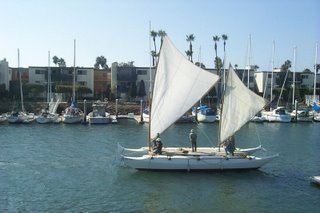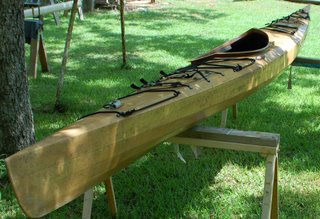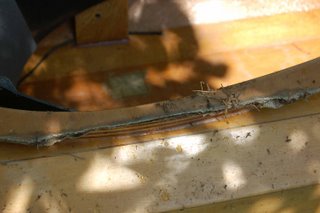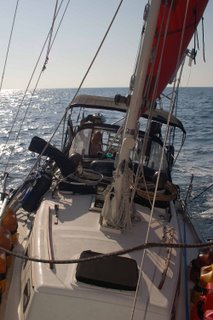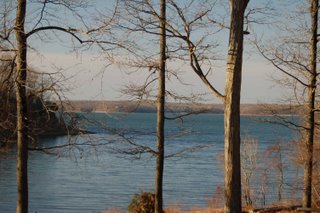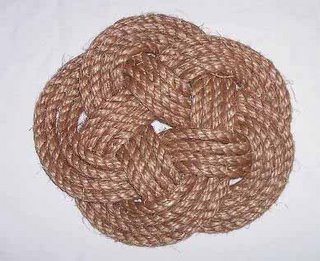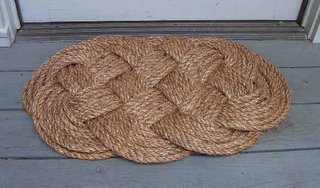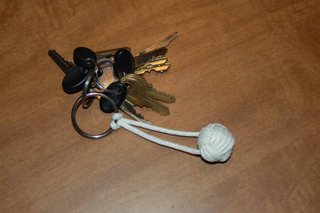 Segundo Vez with her new owners, Houston and Bill Barker of Colorado, Nov. 2006
Segundo Vez with her new owners, Houston and Bill Barker of Colorado, Nov. 2006Wharram's Tiki range of catamarans certainly seemed to fit the bill, and at the time my interest was certainly more geared to smaller boats, so from his many sizes offered I picked the Hitia 17, a simple plywood beachcruiser that could be easily disassembled for trailering and could take me places faster than any kayak. I began the project hopeful that I could complete it in the 250 hours projected by the designer, but like most boatbuilders, I found that I needed twice as long to achieve a finished boat.
After a year of part-time boatbuilding, including building several smaller boats for paying customers, I launched Segundo Vez (Second Time) on the Gulf coast and found that at last I had a boat that was both simple and shallow draft, and could sail well to windward and at a good speed.
I took another road trip to Florida, this time to Tampa, where my brother lived, and cash in hand began visiting first hand many of the boats I'd found in the ads. Most of them were misrepresented and overpriced, but one, a 1968 Grampian 26 that the owner had begun restoring, appeared to be just right, and at a reasonable price. It was certainly big enough to live aboard, and a test sail proved it to be weatherly and easy to handle. I bought it and sailed it home single-handed, spending over a week enroute as I made my way along the Gulf coast.
Owning and sailing a 26-foot monohull with over 4 feet of draft was a new experience for someone coming from a sea kayaking background. I found myself limited as to where I could go, but the necessity to always know one's position when piloting this type of craft taught me a lot about seamanship and navigation. This boat also taught me a lot about boat restoration and refitting, and over time I rebuilt the interior and gradually outfitted the boat for cruising. I later got married on board and cruised south to the Florida Keys and the east coast of Florida with my then-wife and stepdaughter. Although most of this cruise was great, I once again found myself longing for a shallow-draft boat, especially when a Category 4 hurricane threatened the Keys and we found few options for places to go to secure the boat. We were lucky that storm turned when it did.
A few months later, my short-lived marriage ended, I sailed back to Mississippi with the help of a good friend and once again considered resuming the building of my Tiki 26. But I also had a lot of time and money invested in the Grampian, and I needed a boat I could comfortably live on, at least part time, as I was starting my marine carpentry business on the Gulf coast and needed a base there. I decided to keep the boat, as I could not sell it for what I had invested. I hauled out and completely repainted it, changing the color and then re-christening the boat Intensity to get rid of all the bad karma brought aboard by an ex-wife who really had no intention of staying anyway.
I sailed Intensity locally on the Gulf coast for three more years. One of the nicest things about owning a larger boat than a kayak or small open boat is the opportunity to introduce sailing to people who otherwise would never experience it. I always enjoyed taking friends and family members on day trips or short overnight cruises to the nearby barrier islands. But beginning in 2004 hurricane threats began to become more serious and more frequent, and I found myself constantly worrying about where I was going to take my boat to secure it in a storm. Finally in 2005, after riding out Tropical Storm Cindy on board and a near miss with Hurricane Dennis, which turned to north Florida, I found myself with no good place to go when Hurricane Katrina set her course for the Mississippi coast. I lost the boat, like so many of my other fellow sailors in the area, but I was determined to keep sailing.
Even before Hurricane Katrina, I knew about a Wharram Tiki 21 catamaran that was for sale in Ocean Springs, so I called the owner and found that the boat had survived, as it had been moved inland on a trailer. I purchased it shortly thereafter, and took it home for what would prove to be a longer than anticipated refit, see: http://tiki21element.blogspot.com
I wanted the Tiki 21 because it had more weight-carrying capacity than the Hitia 17, as well as two very minimal bunks, one in each hull. It' s not by any stretch of the imagination a good liveaboard vessel, but it has been proven to be exceptionally seaworthy, and a modified version was sailed around the world by Rory McDougal. I knew when I bought it that it would not be a long-term solution to my sailing needs, but I wanted to try a larger Wharram and thought it would be suitable for some smaller adventures while I made up my mind about another cruising boat.
During the long refit process, I spent more time than ever researching boat design, exploring many possibilities in boats I could build or purchase used and refit. I looked at catamarans, trimarans, and monohulls, and made two trips to Florida to look at examples that were for sale. The brilliant simplicity of the Wharram Tiki design kept me coming back to this range of boats, however, and as I rebuilt Element, I figured that another Wharram was in my future. I just wanted to be sure I was making the right decision this time, as I didn't want to keep going through the process of building/rebuilding but hopefully one more time.
Finally, several things converged at nearly the same time to aid in my decision process. I had a prospective buyer for Segundo Vez, so it could be sold, freeing up my work space for building a boat and adding some cash to the construction fund. Element was complete, and at last I had two options on the coast for docking her, so I would have a boat in the water, ready for quick weekend getaways when I needed a sailing fix or got disillusioned with building. I had long ago sold my Tiki 26 plans, but I knew of a new, unused set owned by another Tiki 26 sailor who had planned to build but then bought a used Tiki 26, so no longer needed the plans, so I got a deal on those. And, I found inspiration on the web from another experienced monohull sailor, Thomas Nielsen, who recently sold his deep-draft boat and opted to build himself a Tiki 26, documenting the process with his excellent blog: http://tiki26.blogspot.com/
All these things seemed to be leading in the right direction. Now, Element is in the water in Biloxi, Segundo Vez is at home with her new owners in Colorado, and I have my plans for Tiki 26 number 341, which will become Element II over the course of the next year or two. I'll be picking up the Okoume plywood for the build in a few days, and sometime shortly after the construction will begin.


